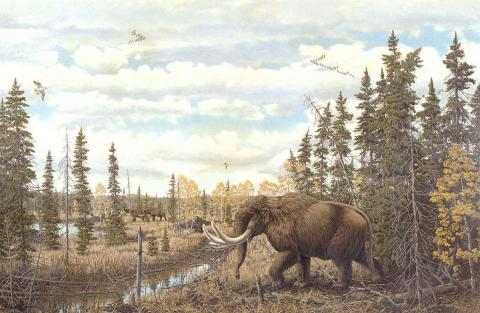Spruce Forests and Parklands
Artist's reconstruction of a Spruce Parkland environment at the Boney Spring locality (Benton County, Missouri). Painting by Robert Larson.
As the glaciers receded, pioneering tundra vegetation was replaced with spruce forests and sedge-dominated wetlands. There is no modern analogue for this biome. Grasses and scattered trees were present in the uplands. These trees would have been largely white and black spruce. Lowlands along rivers and streams were dominated by black spruce, a species that is adapted to cold, saturated environments. Sedges were also common in lowland habitats (Yansa and Adams 2012; Gonzalez and Grimm 2009).
Although some open-ground, tundra-dwelling animals were still present on the landscape (mammoths, stag-moose), others followed these open habitats northwards. For instance, tundra muskoxen are absent from post-LGM deposits in the Midwest. The tundra fauna is replaced with a higher diversity of large herbivores, including: Mastodons, Megalonychid ground sloths, Helmeted Muskoxen, and peccaries. The broader availability of above-ground biomass provided a variety of grazing/browsing niches to these herbivores.
- Northeastern Illinois: 19,000-14,100-cal BP (Gonzalez and Grimm 2009, Saunders et al. 2010)
- Southern Wisconsin: 15,500-14,100 cal BP (Fredlund et al. 1996)
- Lower Michigan: 15,300-11,400 cal BP (Hupy and Yansa 2009)








